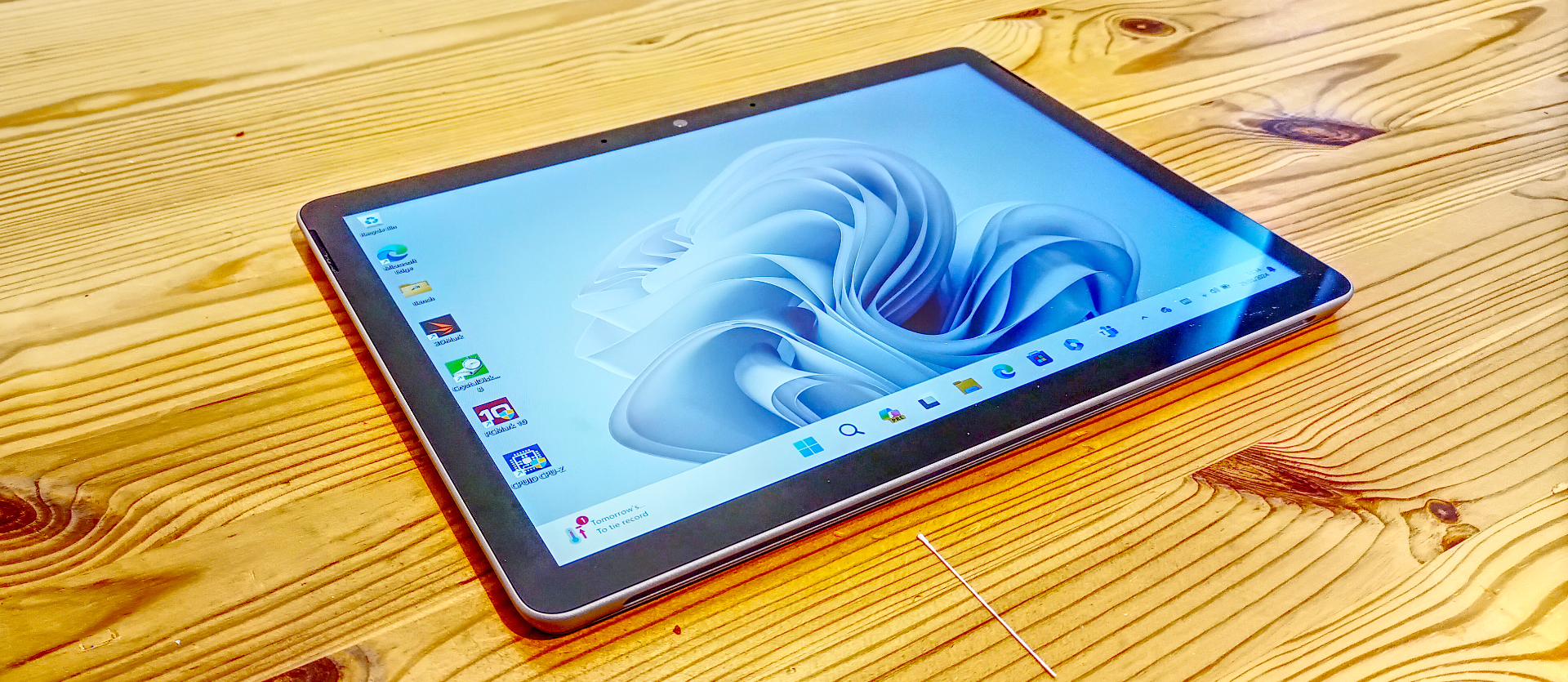TechRadar Verdict
The Surface Go 4 is a disappointing solution that ignores the increasingly sophisticated use of laptops within both business and education. The construction isn’t especially durable, performance is lacklustre, and the cost is disturbingly high. Not much to recommend here.
Pros
- +
Portable
- +
Light
Cons
- -
Poor performance
- -
Comes with zero accessories
- -
A single year of warranty
- -
No upgrades to memory or storage
Why you can trust TechRadar
Microsoft Surface Go 4: 30-second review
Since before the original Surface appeared back in 2012, Microsoft has been pushing hard the concept of Windows as a tablet OS. Twelve years later, that pipedream is no nearer becoming a reality, and with the current success of Chrome OS Chromebooks, it might be even further away.
Despite this, Microsoft continues churning out Surface-branded products, the latest being the Surface Go 4. This is a small 2-in-1 machine designed to tap into those organisations and establishments that like Windows touch-based applications.
Surface is a premium brand, but the Go 4, like the Go 3 beforehand, isn’t meant for creatives or even much more than challenging office tasks.
There are numerous issues the Go 4 inherited from its predecessor that Microsoft chose to do nothing about. But the branded Elephants in this room are that the Surface Go 4 isn’t accomplished as a tablet or a laptop.
The purchaser gets the tablet and a power supply in the box, as Microsoft doesn’t bundle any of the accessories needed to use it as a laptop. How well it works in tablet mode is undermined by the lack of touch-designed applications in a world still heavily orientated to Windows Win32 applications. With such a relatively small screen and the granularity of finger-sized precision, unless all the apps you use have tablet versions, a frustrating exercise awaits the user.
Suppose you buy some of the extensive and reassuringly expensive accessories. In that case, mutating the Go 4 into a laptop is possible, but it will never be as easy to use as hardware built for that specific purpose.
There are three SKUs with different amounts of storage, the cheapest starting at $579/£529 for one with a miniscule 64GB UFS drive.
Sign up to the TechRadar Pro newsletter to get all the top news, opinion, features and guidance your business needs to succeed!
When you consider the specification of a laptop or Chromebook at the same price point, then add on the cost of the large number of accessories needed for laptop use. It makes the Surface Go 4 look decidedly overpriced.
In reviewing this hardware, we always tried to look for a compelling reason to purchase, but the Surface Go 4 has evaded that ambition masterfully.
Microsoft Surface Go 4: Price and availability
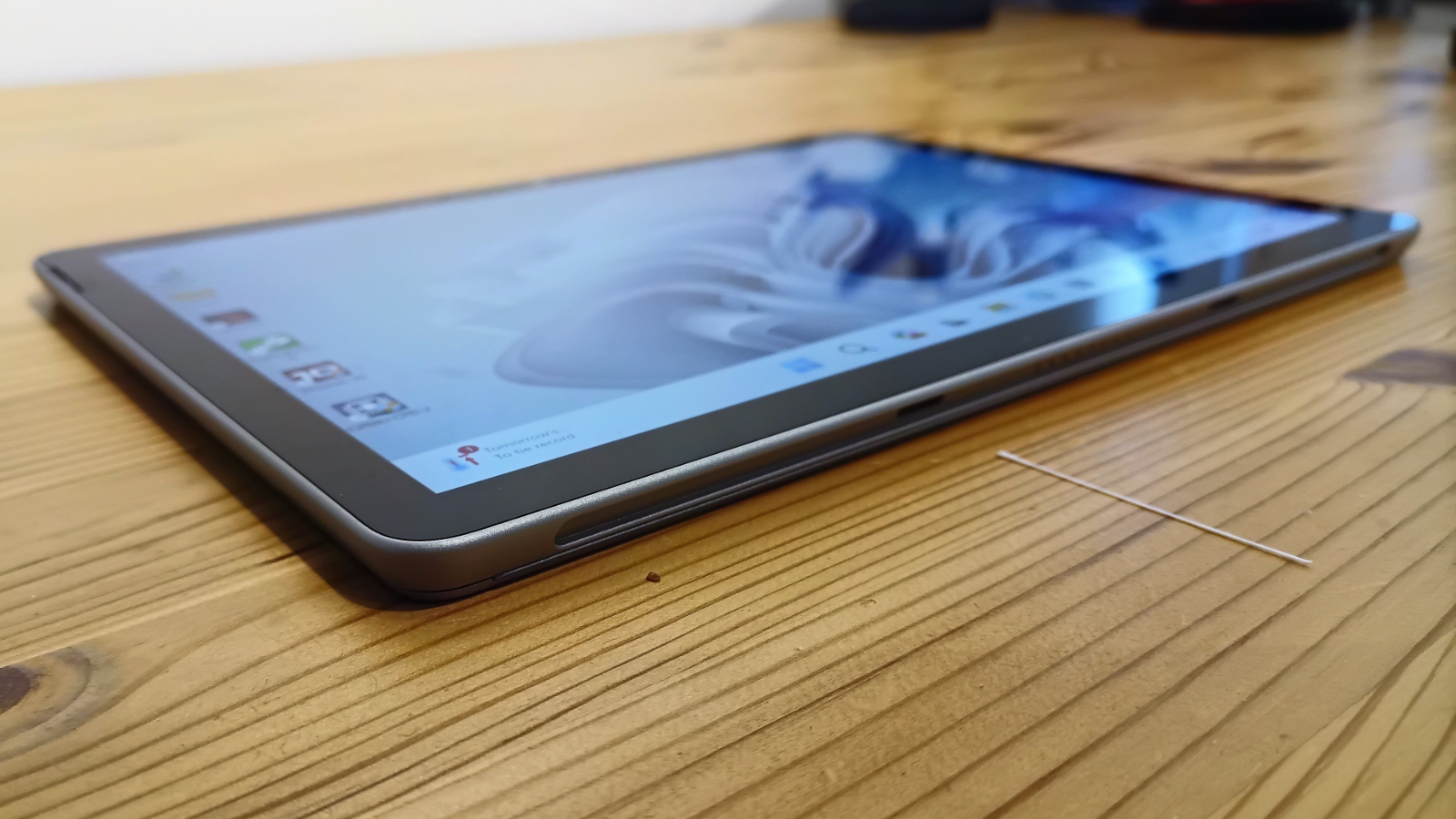
- How much does it cost? From $579/£529
- When is it out? Now
- Where can you get it? Direct from a Microsoft business or education reseller
The Microsoft Surface Go 4 comes in three SKUs that all use the same Intel N200 processor and have 8GB of RAM. What differentiates them is that the cheapest $579/£529 model comes with 64GB of UFS storage, and the two higher options offer 128GB and 256GB of storage. The SKU with the most storage costs $779/£729 for a machine with no keyboard, stylus or case, and only 191GB of free space at first launch. That amount seems excessive.
A keyboard costs another £100 or £125 depending on colour, the Surface mouse is another £80, and the Surface Dock 2 is an eye-watering £260.
And, unless you expected otherwise, this machine can’t be upgraded in any fashion.
If you must have a hybrid design, finding one that represents better value than this one won’t be a challenge.
- Value: 2 / 5
Microsoft Surface Go 4: Specifications
| Item | Specification |
|---|---|
| CPU: | Intel Processor N200 (4 core, 4 thread) |
| GPU: | Intel UHD Graphics (32EU) |
| RAM: | 8GB LPDDR4X |
| Storage: | 128GB UFS 3.1 |
| Screen: | 10.5? PixelSense Display with touch, 350 nits |
| Resolution: | 1920 × 1280 (220 PPI) |
| SIM: | N/A |
| Weight: | 521g (1.15 lbs) |
| Dimensions: | 245 x 175 x 8.3mm |
| Cameras: | 8MP 1080p rear And 1080P front, Windows Hello face authentication camera |
| Networking: | WiFi 6, Bluetooth 5.1 |
| OS: | Windows 11 Pro |
| Battery: | 29 WHr with 24W charger |
| Colours: | Grey |
Microsoft Surface Go 4: Design
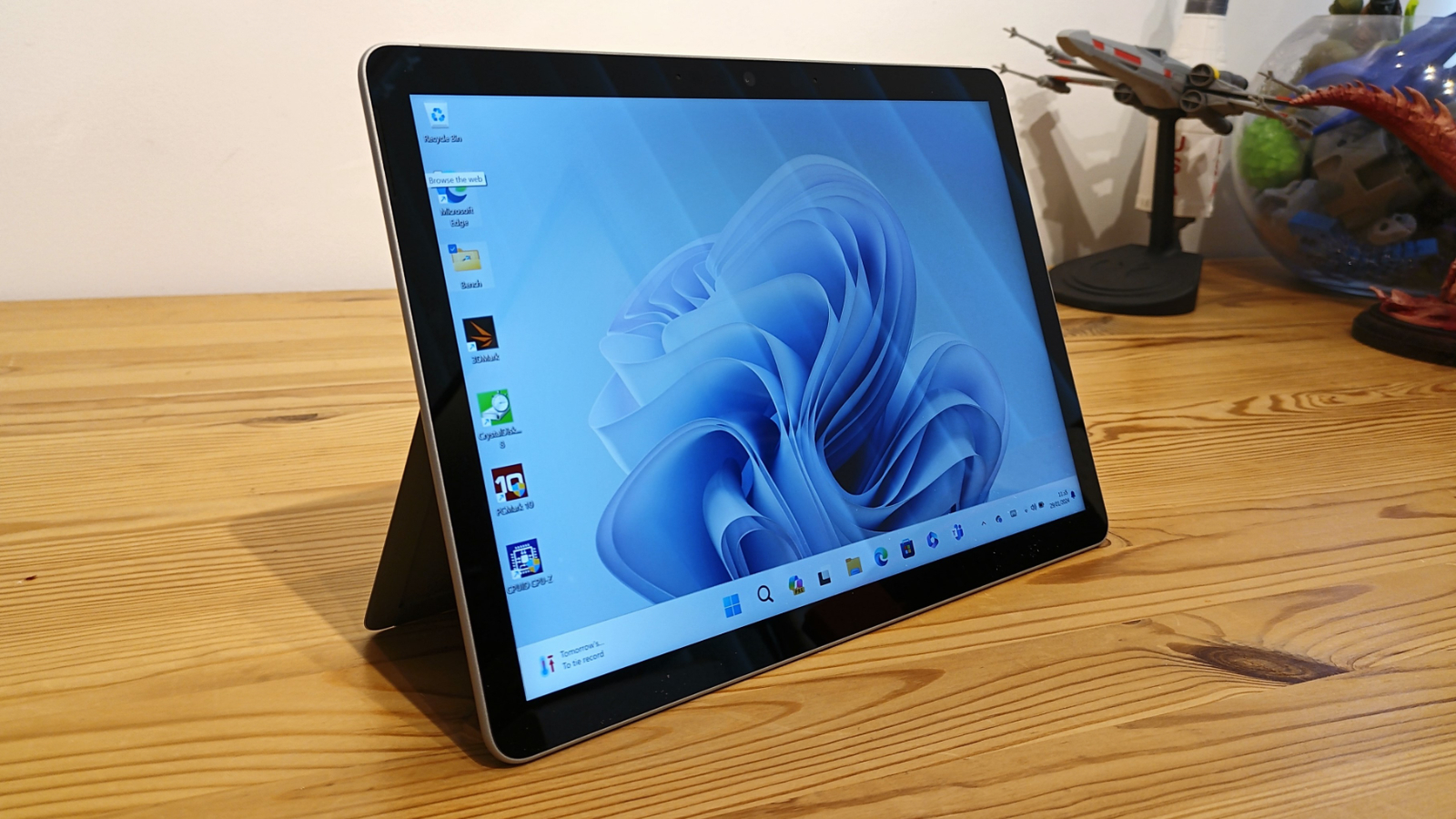
- Almost unchanged from Go 3
- Kickstand included
- Limited ports
What’s striking about the Go 4 is how little Microsoft changed it from the previous model, as from the outside, they are incredibly similar.
This machine is undoubtedly an iPad wannabe, sporting the same 2:3 aspect ratio and a tiny bit larger screen size as the Apple tablet, a product that is amazingly cheaper for the same amount of storage.
The 10.5-inch IPS panel has roughly a 10mm border in all directions, allowing touch actions to move off the display when swiping. But with larger hands, it is possible to confuse the ten-point touch sensor with a misplaced thumb.
The lower edge has a magnetic edge connector for the keyboard if you buy one, while the left side has no ports at all. The most useful side is the right, with an SDcard slot, audio jack and a single USB-C 3.1 port. The top edge has a power button and volume rocker.
The USB port is the only way to charge the machine, so unless you have a docking station or adapter, it isn’t possible to watch media from external storage and charge at the same time. I think we can blame Apple for that minimalist approach, although it didn’t force Microsoft to ape it so slavishly.
One feature of the Surface range from early on was the kickstand, a device that Microsoft laughably insisted could be used on your lap with a flexible keyboard connected.
On the Go 4, the kickstand is integrated and allows the tablet to be stood up with a range of possible angles. It’s extremely thin, and it doesn’t translate back to flat, so any pressure on it while the stand is fully extended is likely to break the hinges or worse.
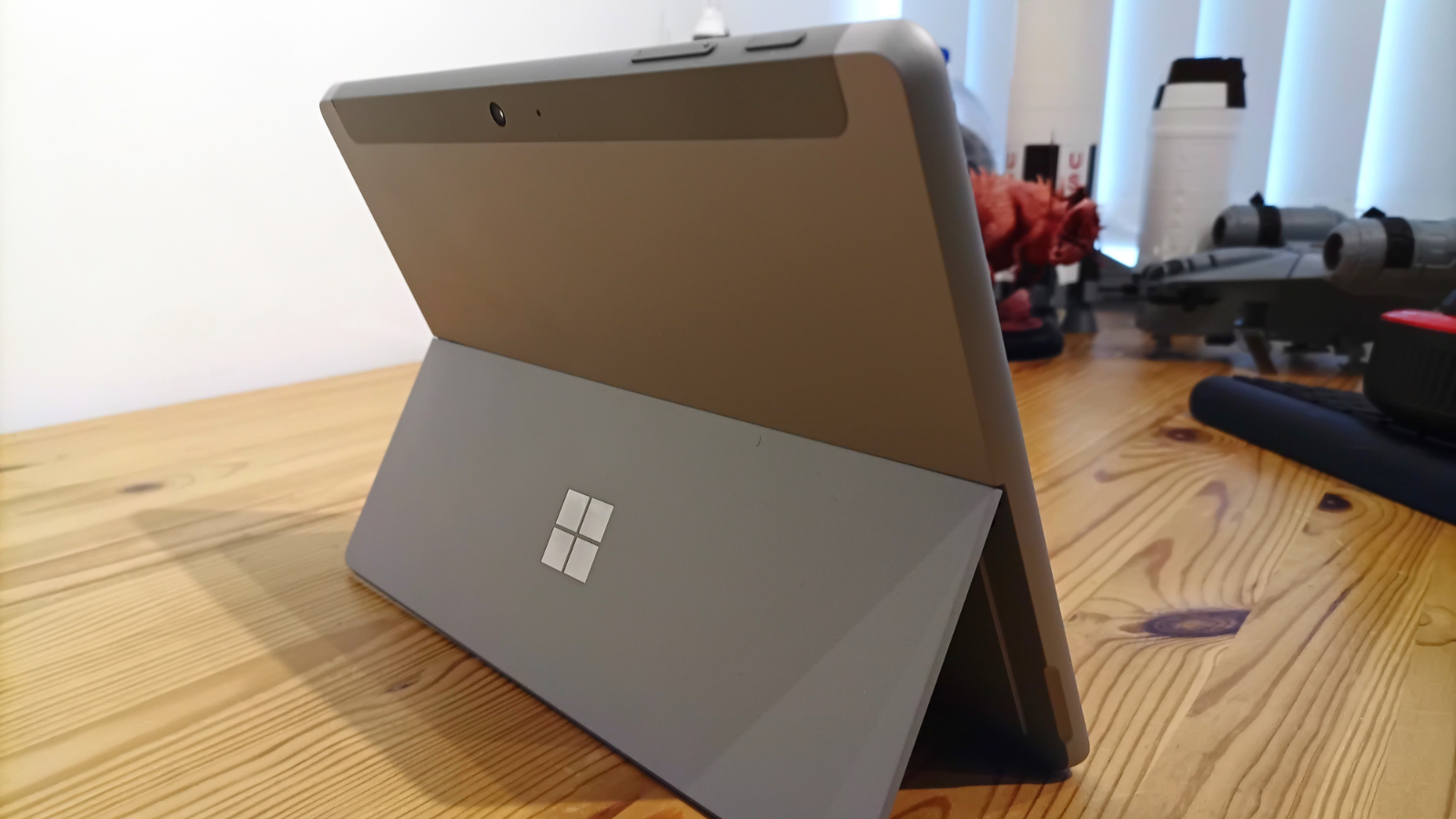
Obviously, you can’t use this on your knees, as it requires a completely flat terrain to balance. But it’s a prerequisite for those who want to spend more and make the Go 4 into a laptop.
One problem with doing that is this device's lack of external ports, with only one USB-C that must serve for peripherals and charging. The solution put forward by Microsoft is an expensive Surface Dock 2, a fully featured docking station with plenty of USB ports, LAN and dual monitor outputs.
That’s an entirely pointless expenditure. Because the Go 4 only has a single USB 3.1 port with 5Gbps of bandwidth, and it can’t magically expand to handle the three 10Gbps USB ports on the dock, never mind the 4K video outputs.
A cheap third-party adapter that allows the USB port to be used while charging is probably a better investment.
I’d talk about how well-designed the accessories were, but none are included with the machine by default. From what this reviewer understands, they appear unchanged from those offered to work with the Go 3.
- Design: 4 / 5
Microsoft Surface Go 4: Hardware
- Intel Core i3-N300
- Limited PCIe 3.0 lanes
- Average battery capacity
Intel pitches different chips at various product sectors, and the N200 in the Go 4 is Alder Lake-N series silicon using the old 10nm fabrication.
We’ve seen a few laptops and mini-PC designs using these in both the N100 and N300 configurations, and none of these have impressed us with their performance.
Based on Intel’s numbering scheme, the N200 is a middle-order solution, but to be brutally honest, the difference between this chip and its lesser N100 is remarkably small.
They both have four Gracemont e-Cores with no hyperthreading and a base frequency of 1.8GHz, 10MB of cache and no overclocking. The N200 has a 300Mhz advantage in the turbo frequency for a single core, up to 3.7GHz, and a 400MHz boost to the turbo on all cores, up to 3.4GHz.
The N200 also comes with a UHD Graphics GPU with 32 Execution units, eight more than the N100, and 64 more shaders. But, as we’ll see in the benchmarking, this makes remarkably little difference to the overall performance or the user experience.
The bigger issue here is that the Alder Lake-N has a cap of 6W of power, limiting how it can use the turbo mode, and the PCI lanes available to this chip cramp its I/O.
All the N-series only have 9 PCIe 3.0 lanes, and those must support both internal storage and external ports with a total PCIe bandwidth of just 8.9GB/s.
When you consider that a single USB 3.1 requires a single lane, and M.2 storage needs at least two or four, starting with only nine lanes limits both the number of ports and storage performance.
This design is meant to be advantageous in power efficiency, being a portable device powered by battery, and how long it can operate away from mains power.
However, taking longer to do things eats into the power efficiency gains, and since Intel didn’t use 7nm or small fabrication of these processors, the power efficiency isn’t as much as it could have been.
The N-series can also only address a maximum of 16GB of single-channel memory, either DDR5 or DDR4. Microsoft decided this system would only get 8GB (all SKUs), but at least it was the DDR5 memory type.
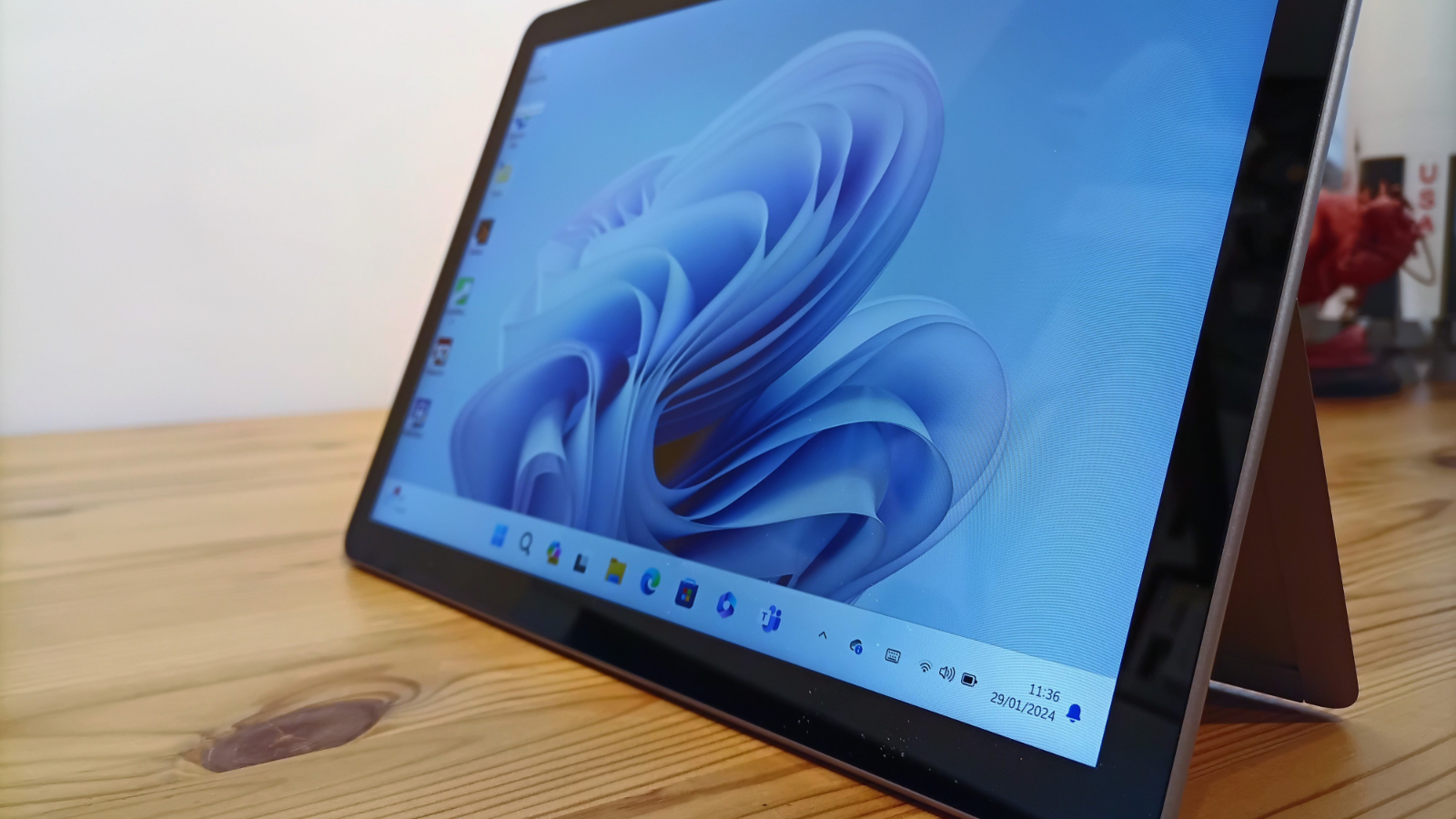
The storage device is a SK Hynix HN8T15DEHKX075, a 2230 M.2 NVMe drive, which costs just $19 in the 256GB capacity used by the best SKU. We’ll discuss the performance of this drive later, but it looks from the bench results that this drive is limited to two PCIe lanes.
An area of this hardware that Microsoft seem keen to promote is battery life, although they don’t mention what the mAh of the battery is. They instead use WH (watts per hour), which they declare is 28WH with a minimum of 26WH.
Others have reported that the battery is 8000 mAh, although that seems on the big side considering the relatively low weight of this machine. Microsoft quotes 12.5 hours of ‘typical use’, with the screen turned down to half brightness and power various power-consuming functions disabled. If it could achieve that running time, it would be wonderful, but our tests suggest that’s not a realistic expectation for most users.
The hardware in this PC is unexciting, and even a Core i3 class laptop from a few years ago would be able to overtake it in most performance tests.
- Features: 3 / 5
Microsoft Surface Go 4: Performance
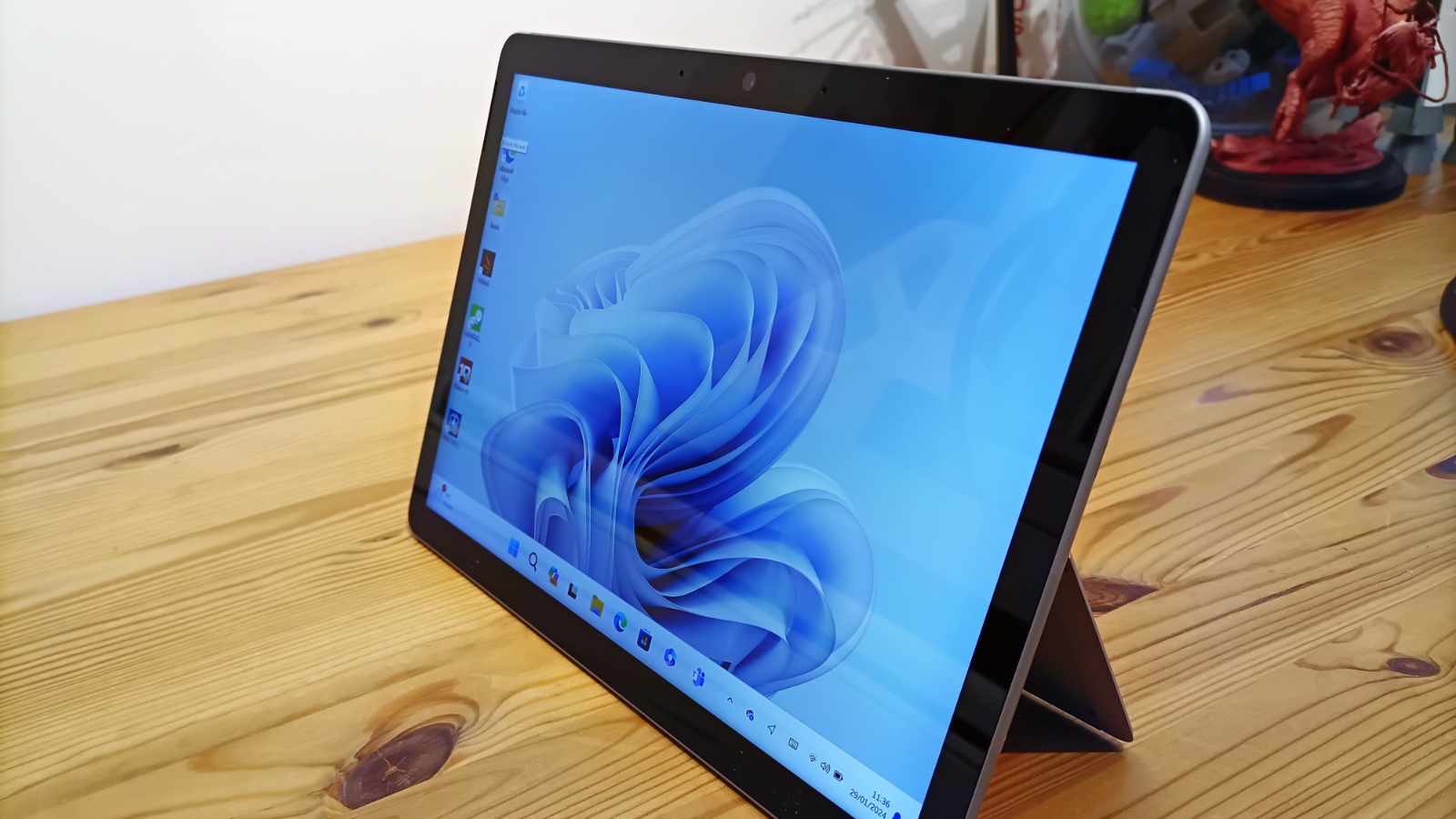
- Better than N100/N95
- DDR5 and 32EU not enough
| Benchmark | Test | Microsoft Surface Go 4 | Meenhong P8 |
|---|---|---|---|
| CPU: | Intel N200 | Intel N100 | |
| Memory: | 8GB DDR5-4800 | 12GB DDR5-3200 | |
| GPU: | UHD Graphics 32EU | UHD Graphics 24EU | |
| 3DMark: | Wildlife | 3,063 | 2,893 |
| Fire Strike | 1163 | 1157 | |
| Time Spy | 402 | 365 | |
| CineBench23: | Single | 570 | 810 |
| Multi | 2440 | 1843 | |
| Ratio | 4.28 | 2.28 | |
| Geek Bench: | Single | AFTER | 913 |
| PCMark: | Multi | AFTER | 2208 |
| OpenCL | AFTER | 3944 | |
| Vulkan | AFTER | 3964 | |
| CrystalDiskM: | Read MB/s | 1090 | 559 |
| Write MB/s | 551 | 507 | |
| PCMark10: | Score | 2127 | 2572 |
| Battery Test | 8h 21m | 5h 51m | |
| WEI | Score | 8.0 | 7.8 |
Having reviewed the Meehong P8 recently, which uses another N-Series processor, I can see that the lacklustre numbers thrown up by the N200 on the Go 4 weren’t a huge surprise.
What’s inexplicable is that the N200 is worse at single-core operations than the N100, though it is better at multi-core tests.
Normally, we’d include the GeekBench scores, but on the Go 4 the app immediately crashed when run. It might be possible to get that working using compatibility mode, but it was always unlikely to deliver spectacular results.
The slightly enhanced 32 Execution Unit version of the GPU does show that it is superior to that in the N100-powered laptop, but that doesn’t make the Go 4 a great choice for games or 3D modelling.
The claimed 12.5 hours of battery life looks excessively generous, and using the PCMark Battery Test (Office), it achieved only about two-thirds of that amount. If this laptop was used for some demanding tasks with screen brightness turned up, it might last only 5 hours or less.
What makes these results significant is that the compared N100 machine, the Meenhong P8, costs only $400. For that money, you get 12GB of DDR5 RAM, 512GB of storage, two USB ports, and HDMI. The final rebuttal to the Go 4 is that the Meenhong comes with a keyboard at no extra cost.
The performance offered by the Go 4 is near the bottom of what is considered useful, and that’s in the top-of-the-range SKU, so beware of the 64GB and 128GB options.
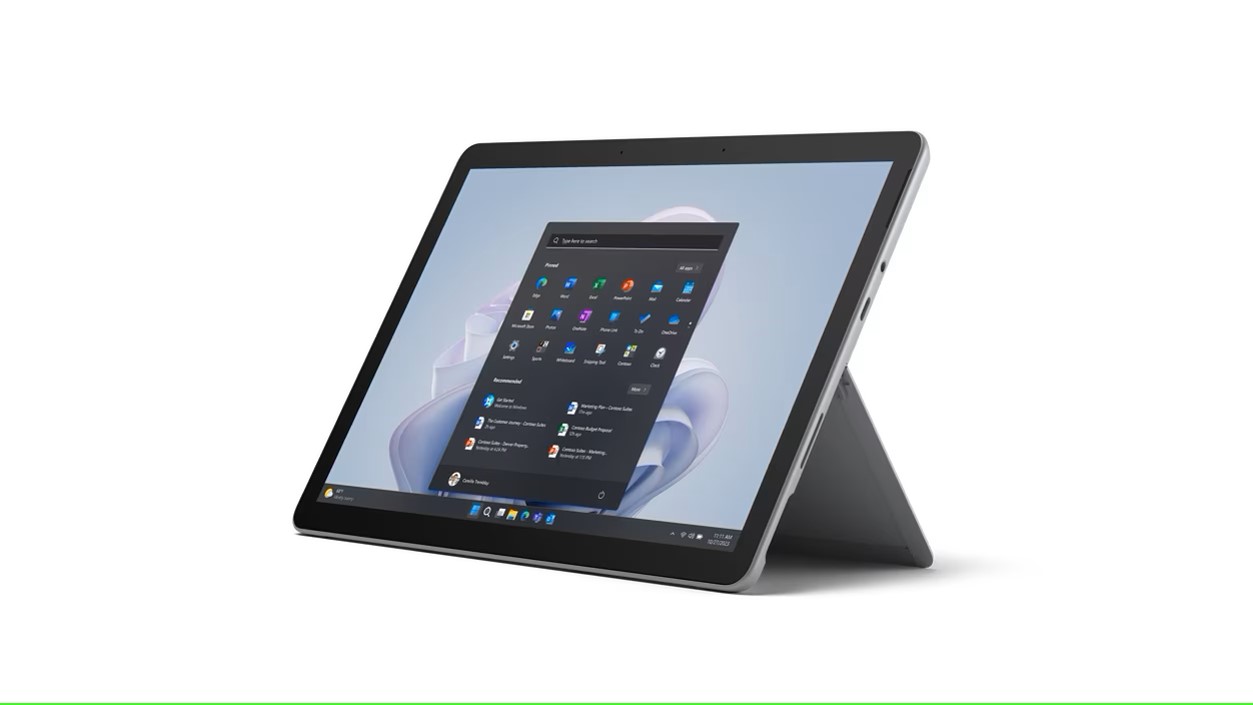
- Performance: 3 / 5
Microsoft Surface Go 4: Verdict
It’s rare to see a product that exists so completely outside the reality of what else is happening in the same commercial space as this one.
The Surface Go 4 looks nice enough, but it isn’t ruggedised in a significant way and only comes with a single year of warranty. Performance is poor, battery life is only adequate, and fully specified for laptop use, it is possible to spend more than $1000 on it.
If you think about the sort of laptop that outlay can get you or how far it might go on a Chromebook, few options offer so little for the considerable expenditure.
How long these might last in educational use is debatable, and business users need something with more get-up-and-go than the N200 powering their PCs.
None of the Surface range has ever truly delivered on the bravado of Microsoft’s initial launch, but the Microsoft Surface Go 4 is easily the most disappointing of this line.
Meanwhile, the Microsoft store and its touch-capable apps are an ongoing scene of desolation that the company seems unwilling or unable to do anything about.
At half the asking price, the Go 4 might have some takers. But it's currently priced, with no accessories, at the same as the HP Envy x360. A machine that’s powered by a Ryzen 5 CPU and has a 13.3-inch display and integrated keyboard, it’s difficult to imagine who might choose the Surface Go 4 over it.
Should you buy a Microsoft Surface Go 4?
| Value | Crazy expensive for poor performance, and a one-year warranty | 2/ 5 |
| Design | Not noticeably reimagined from the Surface Go 3 | 3 / 5 |
| Hardware | Zero upgrades, lacklustre processor, insufficient ports | 3 / 5 |
| Performance | Makes most laptops seem rocket-powered | 3 / 5 |
| Overall | Dire laptop and inadequate tablet make for a poor user experience, our score of 3 might be too generous | 3 / 5 |

Buy it if...
You love Microsoft Surface branding
Perhaps some find this branding and product line appealing and want more. If you do, here is more of the same.
Want to travel light
One thing that this machine has going for it is that it’s light. At just 521g, the Surface Go 4 is easy to carry. However, if you want to use it as a laptop, then a host of accessories is required, and the power supply will increase the weight to the point where it might be more than just a conventional laptop.
Don't buy it if...
You like performance
The new Intel N-series processors are almost the modern equivalent of the Atom line, and nobody ever bought one of those expecting performance fireworks.
The N200 is a four-core CPU with only e-Cores and no hyperthreading, and the UHD Graphics GPU has only 32 Execution units and borrows on the 8GB of main memory.
You need more storage or RAM
Some phones can come with 512GB these days, and laptops with M.2 slots can have 2TB or 4TB is possible. The maximum storage on this machine is 256GB, and the memory is 8GB. These capacities can’t ever be increased.
Also consider
Acemagic X15 Laptop
Acemagic only offers the AX15 with an Intel N95 processor, 16GB of RAM and 512GB of SSD storage for under $300. And for that investment, you get a 15-inch display, a full-sized keyboard, and substantially more ports than the Surface 4 Go.
Read our Acemagic X15 review for more information.
Asus BR1402F 2-in-1 Laptop
A cheaper, more powerful hybrid design with lots of ports double the memory, double the storage, and a significantly longer battery life. It might not have the Surface branding or style, but the user experience is significantly better,
Read our Asus BR1402F 2-in-1 Laptop review for more information.
If this Laptop doesn't fit your requirement, check out our best 2-in-1 collection.
Mark is an expert on 3D printers, drones and phones. He also covers storage, including SSDs, NAS drives and portable hard drives. He started writing in 1986 and has contributed to MicroMart, PC Format, 3D World, among others.
